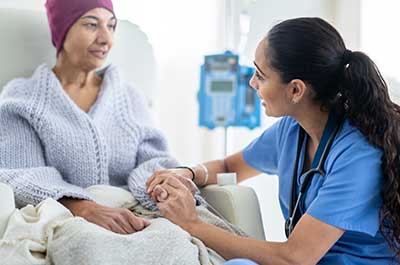Chemotherapy and radiation are standard-of-care treatments for many cancers, but a newer type of treatment, called immunotherapy, harnesses the power of your own immune system to eradicate tumors.
One type of immunotherapy is called chimeric antigen receptor T-cell therapy (or CAR T-cell therapy), and it has been shown to be very effective to treat certain blood cancers like lymphoma, lymphocytic leukemia and myeloma. In some cases, the positive outcomes from this treatment have been long-lasting.
“T-cells are a type of white blood cell that protect you from disease,” says Shatha Farhan, M.D., a medical oncologist and hematologist at Henry Ford Health. “CAR T-cell therapy works by taking your T-cells to a lab, modifying them to recognize and bind to specific proteins on the surface of cancer cells, and infusing them back into your bloodstream. When cancer develops, it has somehow snuck past your immune system. Modifying your T-cells makes your immune system realize cancer is present and helps attack it.”
In some cases, CAR T-cell therapy has even been shown to cure cancer. Here, Dr. Farhan answers questions about this promising cancer treatment.
Q: How might CAR T-cell therapy cure cancer?
A: When CAR T-cells bind to cancer cells, it triggers a series of events that lead to the destruction of these cancer cells. We don’t know why long-lasting effects occur in some patients but not others. It could be related to expansion and persistence of these cells. Expansion is the rapid increase of these cells (which occurs in response to the target protein binding to the cancer cells). This is extremely important to generate the number of CAR T-cells needed to effectively combat the tumor. Persistence is the extended presence of these cells, providing long-term protection from the cancer.
The time needed for these cells to persist might differ among cancers. For example, it seems like CAR T-cells do not need to remain in the body for a long time when treating large B cell lymphoma. But persistence may be more important when treating leukemia. We’re working on how to make them last longer and work better for each specific tumor.
Historically, CAR T-cell therapy has been given as a second- or third-line treatment when other standard-of-care treatments haven’t worked. But as we’ve started to be able to give CAR T-cell therapy sooner, we’ve realized that it’s more effective the earlier we give it.
Q: What are the side effects of CAR T-cell therapy?
A: Because CAR T-cell therapy uses your immune system to fight cancer, it largely leads to side effects that are inflammation-based. It can make someone’s immune system to go into overdrive, resulting in what’s called cytokine release syndrome, or an inflammatory storm.
This can cause mild to severe symptoms that we grade on a scale of one to four. Grade one includes fever, grade two is a fever with low blood pressure and/or low oxygen that resolves with fluids and oxygen supplementation, grades three and four include a severe drop in blood pressure and/or a danger of organ failure, which requires admission into the ICU and additional support.
When CAR T-cell therapy was first given, we didn’t know it could cause cytokine release syndrome. But now that we know, we have a treatment called anti-interleukin-6 that we use to calm it down. It was first used as a treatment for rheumatoid arthritis, but it works well for those with cytokine release syndrome, too. We don’t infuse anyone with CAR T-cell therapy without making sure the pharmacy has it in stock.
Another potential side effect is called immune effector cell-associated neurotoxicity syndrome, or ICANS, which is also inflammation-based. This basically means that CAR T-cell therapy can get into the brain and cause neurological issues like confusion and seizures. For now, we tell people not to drive for two months after treatment because of this.
When we give people CAR T-cell therapy, we’ll have them write the same sentence every day multiple times a day to see if their handwriting changes. If it does, this is sometimes the first clue that they may have ICANS. It’s a temporary side effect and we’ll give steroids as treatment to calm the inflammation. While we’re prepared and able to manage side effects of CAR T-cell therapy, we’re still finding ways to make the treatment even more effective with less side effects.

Cancer Care At Henry Ford
Q: CAR T-cell therapy has recently been in the news for potentially causing secondary cancers. Is this true?
A: In November 2023, the FDA warned of a potential link between CAR T-cell therapy and the development of an additional cancer. Research is ongoing to identify the exact risk and mechanism of secondary cancers post CAR T, but we do know the risk is very, very low. There are a few theories as to why this link may have occurred.
Firstly, as I mentioned, CAR T-cell therapy has been prescribed after other treatments (like chemotherapy) haven’t worked. And chemotherapy can cause DNA damage, making it more likely that a tumor can form. As we’ve been able to give patients CAR T-cell therapy sooner, we’ll be able to see if it has the same effect.
Also, if a patient is susceptible to one cancer, sometimes their body might be at a higher risk for developing other cancers.
Another possible cause is that some patients have acquired mutations in their blood cells (which occurs especially as we get older), and the inflammation caused by CAR T may allow these mutations to grow and expedite the development of another cancer. It is very, very rare that T-cell lymphoma can develop because of a genetic change caused by CAR T-cell therapy. In weighing the risks and benefits of the treatment, the benefits greatly outweigh the risks.
Q: What’s next for CAR T-cell therapy?
A: In the future, CAR T-cell therapy won’t just be for those with blood cancer: there are studies to see how it can reduce the risk of organ rejection for solid organ transplant patients and for those with autoimmune diseases. At Henry Ford Health, we are participating in CAR T-cell therapy studies to treat those with lupus and rheumatoid arthritis.
Research is also being done to see how CAR T-cell therapy can be effective for those with solid tumors (like lung cancer, breast cancer, brain cancer, etc.). While there are limitations – it’s more difficult for modified T-cells to break through solid tumors versus liquid tumors, for example – strides have already been made in clinical trials. And with that, hopefully more people will be able to receive this lifesaving treatment.
Reviewed by Shatha Farhan, M.D., a medical oncologist and hematologist who sees patients at Henry Ford Cancer in Detroit.



